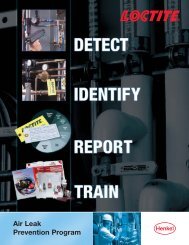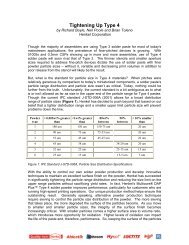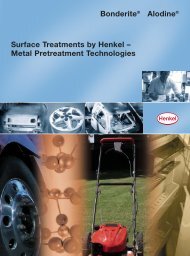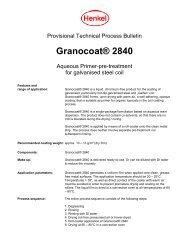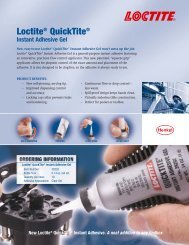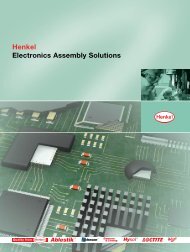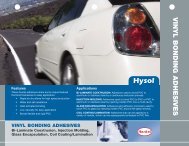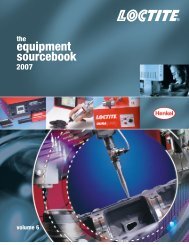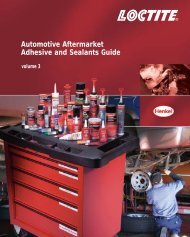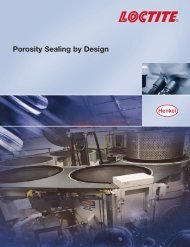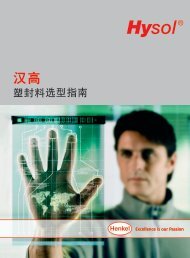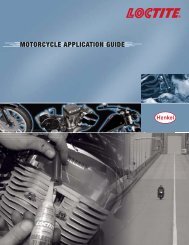SOUND ENGINEERING FROM - Loctite.ph
SOUND ENGINEERING FROM - Loctite.ph
SOUND ENGINEERING FROM - Loctite.ph
- No tags were found...
You also want an ePaper? Increase the reach of your titles
YUMPU automatically turns print PDFs into web optimized ePapers that Google loves.
Assembling Speakers with <strong>Loctite</strong> ® AdhesivesSurround to Frame or ConeThe long bondline and large bond areas in this applicationmay result in moderately high adhesiveconsumption. Thus, most attractive adhesives may bethose that exhibit good bond strength very quickly whenapplied in minimal volume, especially in the productionof low priced or commodity grade loudspeakers.Polyester foam and untreated cloth edges are hygroscopic,and the adhesive cure speed will be influencedby the amount of moisture retained within the part.<strong>Loctite</strong> ® 410 has proven most acceptable for polyesterfoam bonding. It fixtures in approximately five secondswhen the bond is oversprayed with a <strong>Loctite</strong> ® acceleratorsuch as 7113, 712, or 7109. Note that Accelerator 7452should not be used on foam edges, as it is too aggressive.Polyester foam and treated cloth may also bebonded in the same way, but since they may be imperviousto the spray, the accelerator overspray may not bevery effective. Care should be exercised to avoidcreating cosmetic blemishes on the part.Approach attaching rubber edges with some caution,as each of the elastomer families have different characteristics.Adhesive migration may be a cosmetic issue,so consider black or clear adhesives. The stresses on thebondline during use are not especially high, as therubber forms an effective strain relief. There may be hightorque (shear forces) applied by the mounting screwsduring installation of the driver into an enclosure.The recommended surface pre-conditioning for allrubber edges is to wipe the part with 70% isopropylalcohol before bonding. This improves the bondstrength by removing lubricants, plasticizers and moldrelease from the rubber surface.The specific recommendations for bondingsurrounds of IIR (butyl rubber) and NBR (nitrile, orBuna-N rubber) are the same adhesives, but the resultantbond strength is much better with NBR. Since IIR isattacked by some solvents, it may curl up if <strong>Loctite</strong> ®Accelerator 7452 is used, since the carrier solvent isacetone. In this case, <strong>Loctite</strong> ® Accelerator 7113 (heptanebased) should be substituted. Either type of acceleratorworks well with NBR. The need for accelerator pretreatmentof the surround should be evaluated. Someassembly routines rely on the bond remaining pliable fora short period, to allow precise part alignment by hand.Other automated routines require the bond to achievehandling strength in a few seconds.For bonding SBR (styrene-butadiene rubber) edges,<strong>Loctite</strong> ® 401, (used without a primer on the framebondline), is superior. Thermoplastic surrounds such asthose made from Santoprene, Stek TPE-PU (thermoplasticelastomer-polyurethane) and other TPUs all benefitfrom pre-treatment with PRISM ® Primer 770 AdhesionPromoter. The adhesive recommendations are thesame as for conventional rubbers. While EPDMrubber edges are not common, they are occasionallyused, and can be bonded very successfully with <strong>Loctite</strong> ®cyanoacrylate adhesives. The nature of the rubbersuggests that no primer is required.Some attention should be given to weatheringeffects, and both the frame to surround and the surroundto cone bonds should be environmentally testedto ensure a long and trouble-free life for the speaker.Recommended products for the Surround to Frame or Cone Assembly:<strong>Loctite</strong> ® Cyanoacrylate Adhesives 401, 403, 410 or 411.See detailed Product Information on Cyanoacrylates on pages 22 and 23.14



